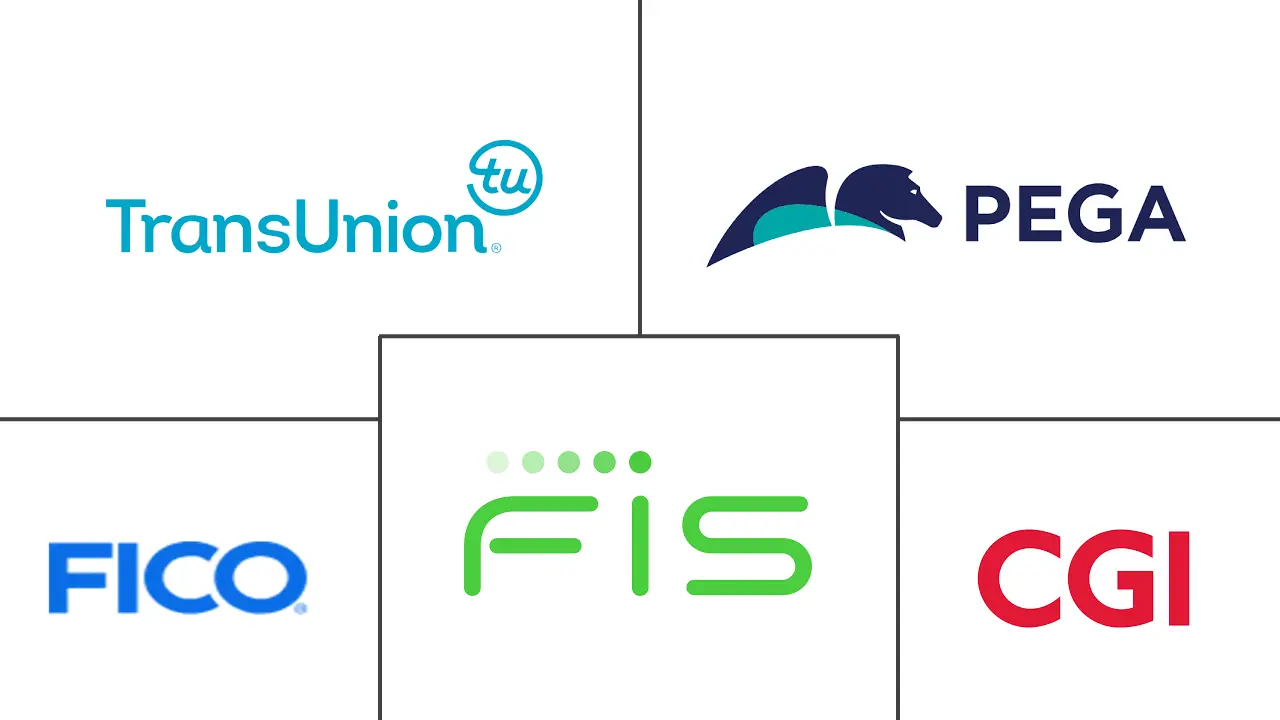Debt Collection Software Market Size and Share
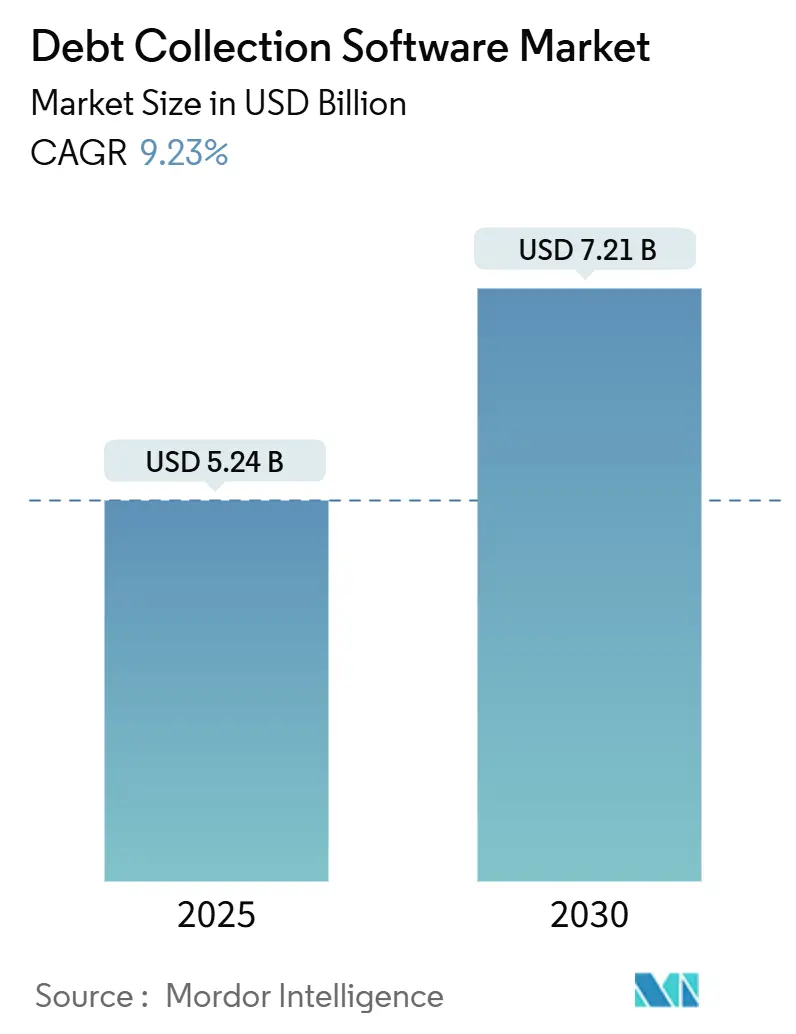
Debt Collection Software Market Analysis by Mordor Intelligence
The debt collection software market size is estimated at USD 5.24 billion in 2025 and is forecast to reach USD 7.21 billion by 2030, expanding at a 9.23% CAGR over the period. Rapid digital transformation inside banks, fintechs, and utilities underpins this growth as executives prioritize real-time analytics, omnichannel engagement, and cloud migration to cut coverage costs and raise liquidation rates. AI-enabled segmentation lowers operational expenses by up to 70%, allowing agencies to handle larger volumes without proportional head-count growth. Cloud infrastructure rationalization, similar to Equifax’s removal of 36 data centers, continues to release capital back into product innovation. Meanwhile, expanding Buy-Now-Pay-Later (BNPL) portfolios and gig-economy payment behavior inject new accounts into collection pipelines, supporting sustained software demand. Mature vendors protect share through compliance automation and global support, but cloud-native challengers leverage faster deployment cycles to penetrate mid-market segments.
Key Report Takeaways
- By component, software platforms accounted for 78% revenue share in 2024, while services are projected to post the highest CAGR at 12.2% through 2030.
- By deployment mode, the cloud segment held 64% of debt collection software market share in 2024 and is on track for a 13.6% CAGR to 2030.
- By organization size, large enterprises retained 57% share of the debt collection software market size in 2024; small and medium enterprises are expanding fastest at 13.4% CAGR.
- By end-user industry, financial services led with 41% revenue share in 2024; retail and e-commerce is advancing at a 15.3% CAGR on the back of BNPL growth.
- By geography, North America generated 38% of 2024 revenues, whereas Asia-Pacific is projected to grow at 14.7% CAGR, the highest among all regions.
Global Debt Collection Software Market Trends and Insights
Drivers Impact Analysis
| Driver | (~) % Impact on CAGR Forecast | Geographic Relevance | Impact Timeline |
|---|---|---|---|
| Rising Adoption of AI-powered Predictive Analytics among Collection Agencies in North America | +2.8% | North America, spill-over to EU | Medium term (2-4 years) |
| Growth in Buy-Now-Pay-Later Portfolios Driving Account Volume in Europe | +2.1% | Europe, expanding to APAC | Short term (≤ 2 years) |
| Increasing Digital Payment Delinquencies from Gig-Economy Workers in Asia | +1.9% | APAC core, emerging in MEA | Medium term (2-4 years) |
| Integration of Collection APIs into Core-Banking Modernisation Programs | +1.7% | Global, concentrated in developed markets | Long term (≥ 4 years) |
| Emergence of Hyper-automation & RPA to Reduce Roll Rates in Telecom & Utilities | +1.2% | Global, early adoption in North America & EU | Medium term (2-4 years) |
| Source: Mordor Intelligence | |||
Rising Adoption of AI-powered Predictive Analytics among Collection Agencies in North America
Machine-learning models processing more than 2,500 variables now guide 57% of U.S. agencies, quadrupling collector productivity and trimming costs by up to 70%. FICO’s platform revenue climbed 31% year over year as lenders embedded predictive scoring into post-charge-off workflows. [1]Fair Isaac Corporation, “FICO Reports Fiscal 2024 Results,” fico.com Personalized repayment plans derived from AI segmentation have lowered loan delinquencies by 25% and bad debt by 20%, while automated compliance checks ensure adherence to FDCPA and Reg F across 90% of interactions. [2]Floatbot Inc., “Conversational AI Improves Collection Outcomes,” floatbot.ai
Growth in Buy-Now-Pay-Later Portfolios Driving Account Volume in Europe
BNPL transactions topped 45 million worth EUR 4.8 billion (USD 5.2 billion) in 2022, and consumers under 35 show higher roll rates that require agile reminder strategies. Regulatory studies confirm SMS nudges cut late payments by 20%. From 2026, the European Consumer Credit Directive places BNPL under full supervision, compelling providers to embed advanced reporting modules. Traditional banks entering instalment finance now demand enterprise-grade platforms that unify revolving credit and BNPL servicing.
Increasing Digital Payment Delinquencies from Gig-Economy Workers in Asia
Roughly 296 million Southeast Asian adults remain unbanked, yet rely on mobile wallets for income flows. Scorecards enriched with smartphone metadata raise approval rates by 32% and improve model predictiveness by 39.9%. Collection stacks integrating these alternative data feeds achieved 21.9% risk-cost reduction, highlighting the value of localized analytics.
Integration of Collection APIs into Core-Banking Modernisation Programs
Banks embedding collection APIs directly inside core systems can trigger early-stage workflows in real time. FIS generated USD 6.9 billion from Banking Solutions in 2024 as institutions prioritized this architecture. CGI’s API-first platform managing New York City parking violations is forecast to channel nearly USD 1 billion annually, illustrating public-sector applicability.
Restraints Impact Analysis
| Restraint | (~) % Impact on CAGR Forecast | Geographic Relevance | Impact Timeline |
|---|---|---|---|
| Data-Privacy Regulations Limiting Third-Party Data Enrichment in the EU | -1.8% | EU, expanding globally | Long term (≥ 4 years) |
| High Switching Costs from Legacy Mainframe Collection Suites in Tier-1 Banks | -1.3% | Global, concentrated in developed markets | Long term (≥ 4 years) |
| Limited Cloud Connectivity in Sub-Saharan Africa Constraining SaaS Adoption | -0.9% | Sub-Saharan Africa, isolated impact | Long term (≥ 4 years) |
| Rising Consumer Litigation Driving Stricter Contact-Frequency Caps in the US | -0.7% | United States, potential spillover to Canada | Medium term (2-4 years) |
| Source: Mordor Intelligence | |||
Data-Privacy Regulations Limiting Third-Party Data Enrichment in the EU
GDPR penalties surged in 2024, with Meta fined EUR 1.2 billion (USD 1.3 billion), signaling tighter scrutiny that curbs access to auxiliary data sets. [3]European Data Protection Board, “EDPB Annual Report 2024,” edpb.europa.eu Debt collectors must now prove data minimization and explainability, adding cost and complexity, especially for SMEs.
High Switching Costs from Legacy Mainframe Collection Suites in Tier-1 Banks
Migrating thirty-year databases to cloud-based engines can cost as much as USD 650,000 per implementation. TransUnion’s multi-year OneTru program illustrates the scale of investment and validation required to safeguard audit trails.
Segment Analysis
By Component: Software Platforms Extend Leadership
Software platforms generated 78% of 2024 revenue, underpinned by demand for end-to-end workflow orchestration. The debt collection software market size attributed to platforms reached USD 4.1 billion, reflecting widespread substitution of fragmented point tools. Services, while smaller, are scaling at 12.2% CAGR as clients seek configuration, integration, and managed analytics to extract value from AI models. FICO booked USD 798 million in software revenue, yet the 31% surge in platform recurring income underscores the pivot to subscription economics.
Cloud-based codebases shorten deployment cycles from months to weeks, driving 91% automation of loan processes at fintech lenders such as Upstart. Professional services fill critical knowledge gaps in health-care revenue-cycle integration, where billing complexity demands specialized mapping. CGI, for instance, recorded 21% growth in managed-services bookings as hospitals outsource maintenance of heavily regulated workflows.
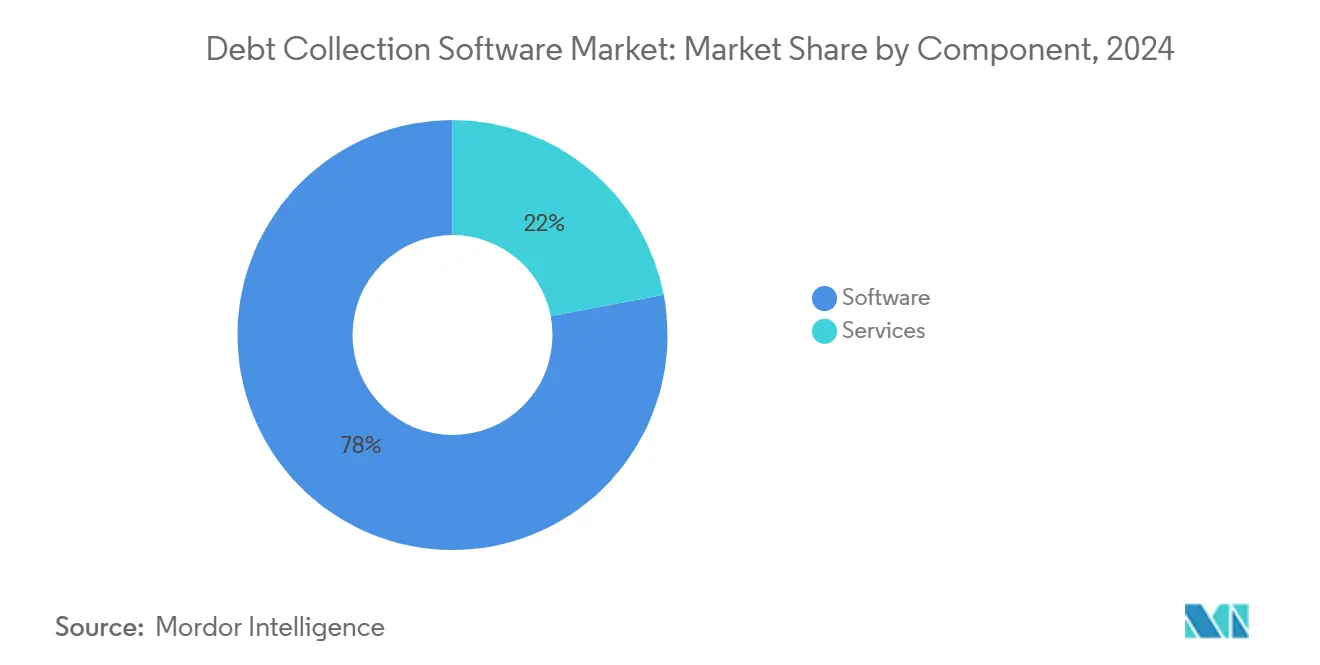
Note: Segment shares of all individual segments available upon report purchase
By Deployment Mode: Cloud Migration Reshapes Economics
Cloud environments held 64% of 2024 revenue and posted the fastest adoption at 13.6% CAGR. Infrastructure rationalization saved Equifax USD 300 million after closing 36 facilities, proving that large-scale migration can unlock budget for innovation. Hybrid approaches combine on-prem tokenization with public-cloud analytics to satisfy sovereignty rules in government and health-care. Oracle’s consumption-based pricing lowers barriers for mid-market adopters, while built-in AI services help agencies test new strategies without major capital outlay. [4]Oracle Corporation, “OCI Pricing Overview,” oracle.com
Security perceptions continue to improve as hyperscalers invest billions in zero-trust frameworks. Equifax notes that 85% of its revenue already runs in cloud, with uptime and latency metrics surpassing legacy data-center benchmarks.
By Organization Size: SMEs Narrow the Capability Gap
Large enterprises retained 57% revenue share in 2024, yet SMEs are expanding at 13.4% CAGR, reflecting the democratization of advanced analytics through subscription models. Tiered packaging lets emerging agencies license only the modules they need, adding AI-driven segmentation later as volumes grow. European regulators introduced SME-tailored privacy guidance to relieve compliance burdens, smoothing adoption curves.
Enterprise buyers still demand extensive customization, regional data residency options, and multi-product servicing within a single workspace. These requirements prolong sales cycles but yield higher average contract values, sustaining incumbents’ R&D budgets for predictive modeling and workflow engines.
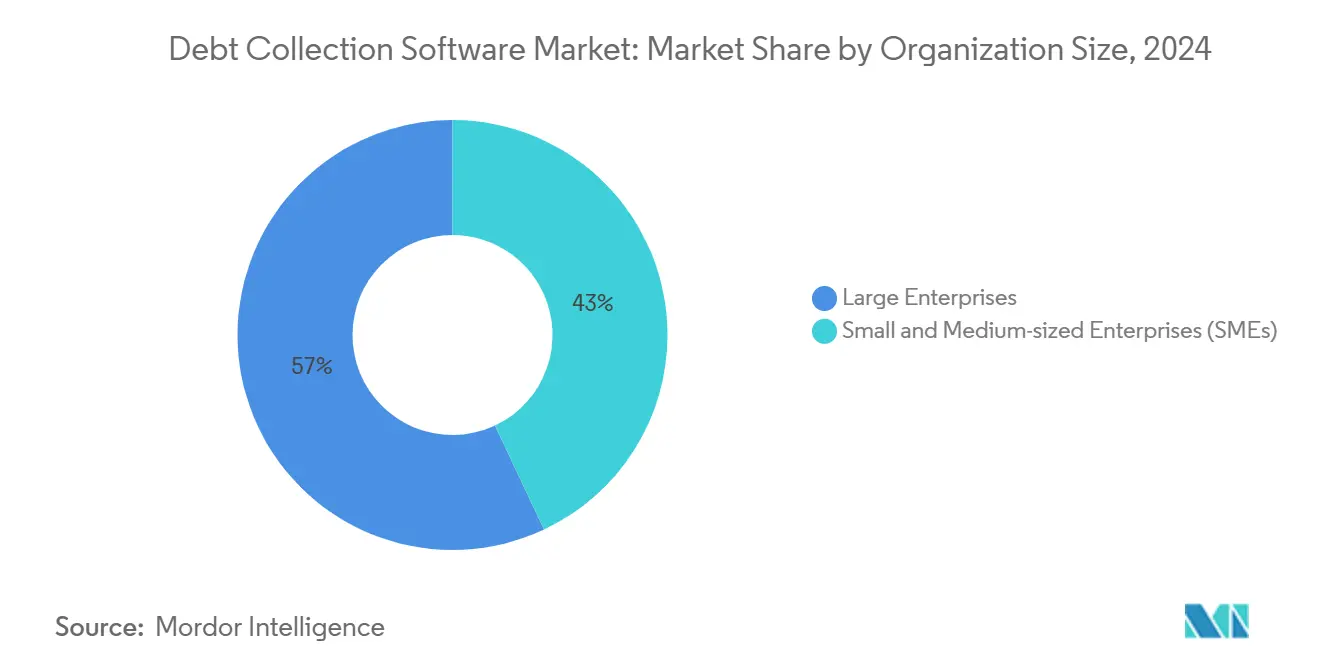
Note: Segment shares of all individual segments available upon report purchase
By End-user Industry: Retail Outpaces Traditional Leaders
Financial institutions controlled 41% of 2024 spending, but retail and e-commerce display the highest trajectory at 15.3% CAGR as BNPL balances swell worldwide. Healthcare revenue-cycle platforms, valued at USD 148.91 billion in 2024, increasingly embed collection APIs, pulling vendors into clinical billing ecosystems. Telecom operators use real-time usage data for proactive outreach before unpaid bills threaten service churn.
The debt collection software market share for retail is set to rise as global BNPL receivables approach USD 576 billion in 2025, driving merchants to formalize post-purchase recovery strategies. Government entities also modernize, with CGI’s New York City system routing nearly USD 1 billion in parking fines annually, illustrating public-sector digitization potential.
Geography Analysis
North America generated 38% of 2024 revenue, aided by clear regulatory guidelines and a sophisticated credit ecosystem. U.S. agencies operate under FDCPA and Reg F, which now permit limited-content messages, encouraging omnichannel design. Canada benefits from cross-border vendor availability, whereas Mexico’s fintech law fosters domestic SaaS adoption.
Europe remains compliance-centric, where GDPR and the upcoming Consumer Credit Directive influence feature road-maps centered on transparency and reporting. Germany and France favor on-prem encryption layers over pure-cloud deployments, while the United Kingdom maintains agile regulatory sandboxes despite exiting the EU.
Asia-Pacific leads pace at 14.7% CAGR, thanks to mobile-first banking and a sizable unbanked community. China’s super-apps produce granular borrower telemetry, whereas India’s digital public infrastructure offers open APIs that vendors plug into for instant KYC checks. Southeast Asian markets rely on alternative data partnerships, exemplified by GBG and CredoLab’s scoring uplift. Sub-Saharan Africa remains constrained by patchy connectivity, slowing SaaS penetration despite rising smartphone adoption.
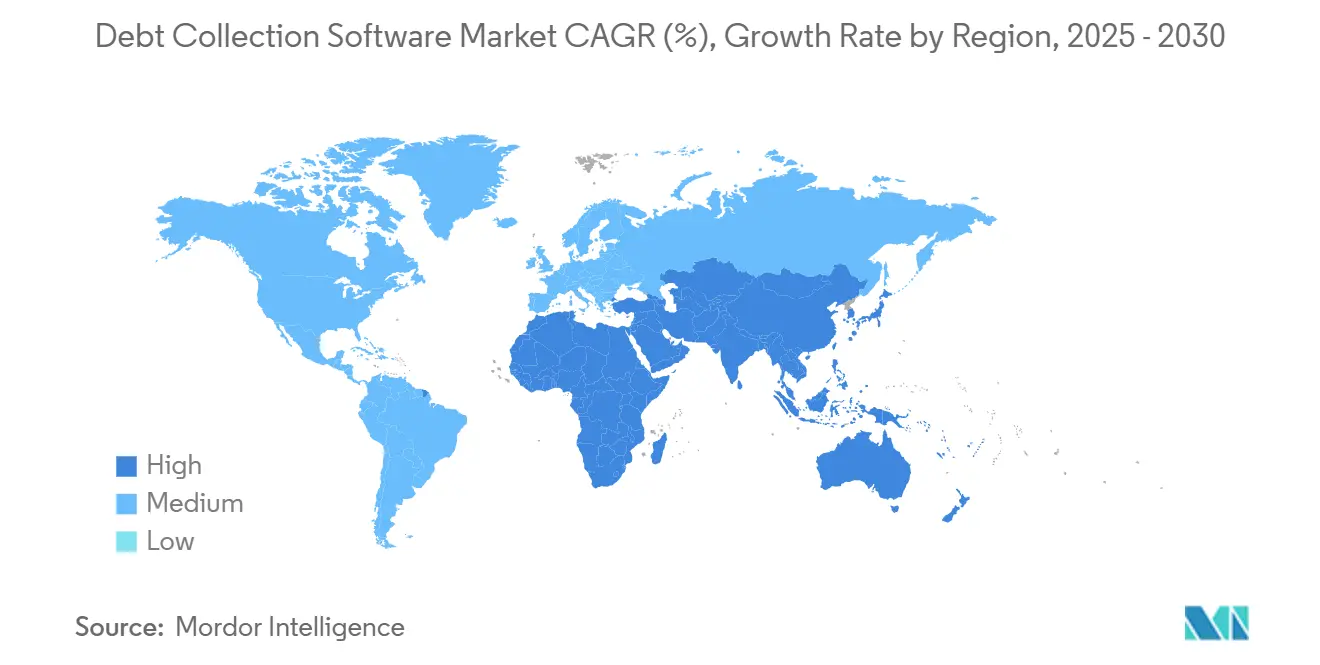
Competitive Landscape
Market structure is moderately concentrated. FIS, CGI, FICO, and TransUnion anchor enterprise deals through bundled consulting and data assets. FICO’s rapid annual recurring revenue rise illustrates demand for turnkey AI modules, while TransUnion’s OneTru cloud rebuild shows incumbents investing to stay relevant.
Strategic priorities revolve around API-first design, zero-trust security, and low-code configurability. Leading vendors integrate conversational AI that automates 90% of inbound queries, improving promise-to-pay adherence by 60%. M&A targets include niche analytics firms or regional SaaS providers; CGI’s USD 54 million Momentum deal widens its U.S. federal footprint.
Challengers such as Katabat and Gaviti emphasize rapid time-to-value for SMEs with pre-configured workflows and usage-based pricing. Voice analytics, real-time sentiment tracking, and adaptive payment portals remain feature battlegrounds. As cloud resiliency and regulatory capabilities converge, relationship capital and proprietary data increasingly define durable differentiation.
Debt Collection Software Industry Leaders
-
Fidelity National Information Services, Inc. (FIS)
-
CGI Inc.
-
TransUnion LLC
-
Pegasystems Inc.
-
Fair Isaac Corporation (FICO)
- *Disclaimer: Major Players sorted in no particular order
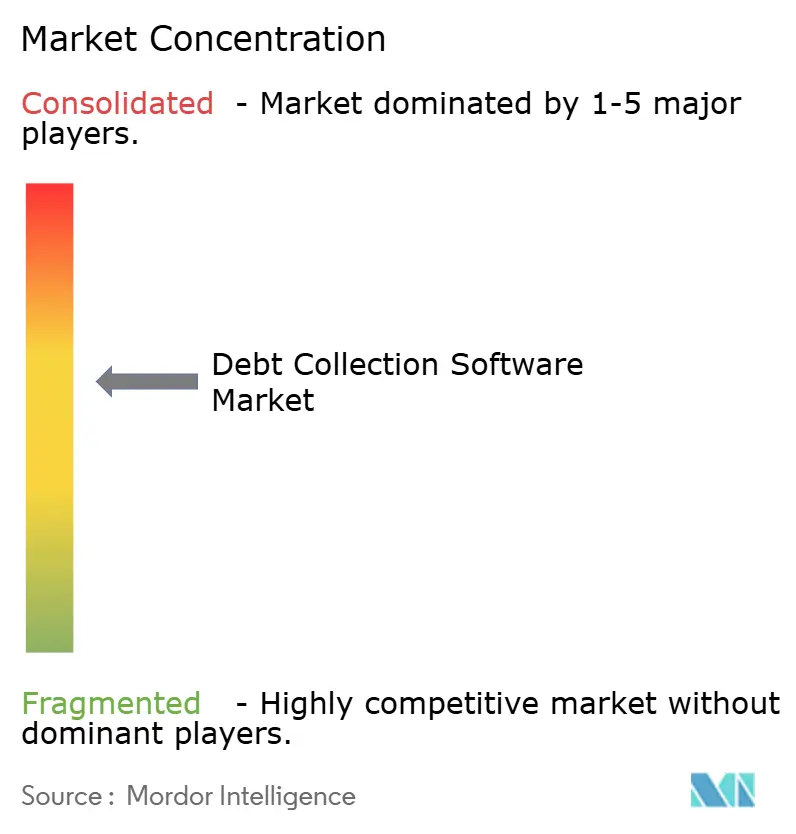
Recent Industry Developments
- January 2025: FIS completed the USD 13.5 billion acquisition of Global Payments’ Issuer Solutions business, expanding issuer processing scale and enabling tighter linkage between transaction data and downstream collection workflows.
- January 2025: FIS divested its remaining Worldpay stake for USD 6.6 billion, freeing capital for AI roadmap acceleration while retaining partnership rights for joint merchant-collection initiatives.
- December 2024: CGI acquired Aeyon LLC to enhance federal services capabilities, positioning its Advantage suite for larger public-sector collection contracts.
- November 2024: FICO reported record USD 1.72 billion revenue with 31% growth in platform recurring income on the strength of predictive analytics uptake.
Research Methodology Framework and Report Scope
Market Definitions and Key Coverage
Our study defines the debt collection software market as the global revenue generated from packaged platforms and cloud services that automate delinquent account follow-up, omnichannel borrower outreach, compliance logging, dispute management, and analytics for first- and third-party recoveries across consumer and commercial credit portfolios. Solutions that ship as modules within broader loan-origination or enterprise resource-planning suites are captured only when offered and billed as standalone collections tools.
Scope Exclusion: Custom in-house scripts, basic dialers without payment workflows, and BPO fee income are outside this scope.
Segmentation Overview
- By Component
- Software
- Services
- By Deployment Mode
- Cloud-based
- On-premises
- By Organization Size
- Small and Medium-sized Enterprises (SMEs)
- Large Enterprises
- By End-user Industry
- Financial Institutions (Banks and NBFCs)
- Collection Agencies
- Healthcare Providers
- Government and Public Sector
- Telecom and Utilities
- Retail and E-commerce
- Other End-user Industries
- By Geography
- North America
- United States
- Canada
- Mexico
- Europe
- United Kingdom
- Germany
- Spain
- France
- Rest of Europe
- Asia-Pacific
- China
- India
- Japan
- Rest of Asia-Pacific
- South America
- Brazil
- Colombia
- Argentina
- Rest of South America
- Middle East and Africa
- Middle East
- Gulf Cooperation Council (GCC)
- Turkey
- Rest of Middle East
- Africa
- South Africa
- Nigeria
- Rest of Africa
- Middle East
- North America
Detailed Research Methodology and Data Validation
Primary Research
We interviewed product heads at leading platform providers, recovery managers within banks, fintech lenders in Asia-Pacific, and compliance consultants in Europe. Their insights validated cloud migration speeds, average seats per deployment, and regional price sensitivity, letting us calibrate conversion ratios that secondary data alone cannot surface.
Desk Research
Mordor analysts first assembled an evidence stack from open sources such as the Federal Reserve Consumer Credit data set, European Central Bank non-performing loan dashboards, FDCPA and GDPR regulatory circulars, U.S. Bureau of Labor Statistics wage series for collections agents, and trade filings at the Consumer Financial Protection Bureau. Annual reports, 10-Ks, and investor decks of listed vendors added pricing bands and deployment splits, while patent abstracts on Questel and deal announcements within Dow Jones Factiva flagged emerging AI features reshaping average selling prices.
These references anchor baseline installation counts, switching rates, and SaaS adoption curves.
Further context came from associations like ACA International and Finance & Leasing Association, plus customs shipment codes for on-premise servers. The list above is illustrative; many additional public and subscription sources were reviewed to test consistency and close data gaps.
Market-Sizing & Forecasting
A top-down spend pool was built from credit-portfolio volumes, delinquency rates, and weighted recovery-cycle counts; these were converted to software outlays using penetration and seat-pricing matrices before being further filtered through deployment-mix assumptions. Select bottom-up cross-checks, supplier revenue roll-ups, and sampled user-license multipliers aligned totals within an acceptable variance band. Key variables include: (1) global consumer debt stock, (2) non-performing loan ratios, (3) cloud versus on-premise share, (4) average subscription fee per collector seat, and (5) regulatory change frequency driving refresh cycles. Forecasts rely on multivariate regression blended with scenario analysis, where cloud uptake elasticity and AI pricing premiums steer CAGR trajectories.
Data Validation & Update Cycle
Modeled outputs pass three layers of analyst review; variance thresholds trigger re-runs, and anomalies are re-checked with respondents. We refresh every twelve months and issue interim updates when regulatory shifts or major M&A materially alter baselines. A final pre-publication sweep ensures clients receive the latest view.
Why Our Debt Collection Software Baseline Earns Trust
Published estimates diverge because firms frame the market differently, convert currencies on varied dates, and refresh at unequal tempos.
Key gap drivers often stem from whether adjacent accounts-receivable modules are bundled, how on-premise end-of-life revenues are treated, and the aggressiveness of cloud-premium escalators. Mordor's disciplined scope filters out peripheral AR tools, applies mid-year average exchange rates, and pairs price ladders with seat counts gathered directly from users, yielding a balanced number.
Benchmark comparison
| Market Size | Anonymized source | Primary gap driver |
|---|---|---|
| USD 5.24 B (2025) | Mordor Intelligence | - |
| USD 5.34 B (2024) | Global Consultancy A | Bundles AR automation and payment portals, inflating total |
| USD 4.80 B (2024) | Industry Publication B | Excludes cloud SaaS upsells, relies on older on-premise license data |
| USD 4.11 B (2024) | Regional Consultancy C | Limits geography to OECD and uses 2023 FX rates |
In sum, Mordor's transparent variable selection, annual refresh cadence, and dual-path modeling give decision-makers a dependable, reproducible baseline that avoids over- or under-statement while staying fully traceable to real-world signals.
Key Questions Answered in the Report
What is the current value of the debt collection software market?
The market is valued at USD 5.24 billion in 2025 and is forecast to reach USD 7.21 billion by 2030.
Which deployment mode is growing fastest?
Cloud-based deployments are expanding at a 13.60% CAGR, driven by infrastructure savings and elastic scalability.
Why are SMEs adopting debt collection software now?
Subscription pricing and pre-configured AI modules have lowered entry barriers, allowing SMEs to access capabilities once reserved for large banks.
How will EU regulation affect BNPL collections?
Starting 2026, the Consumer Credit Directive will bring BNPL under formal supervision, requiring enhanced reporting and consumer-protection features within collection platforms.
Which region shows the highest growth potential?
Asia-Pacific is projected to post a 14.7% CAGR as mobile-first banking and alternative data scoring expand credit access.
What role does AI play in modern collection strategies?
AI-powered predictive analytics segment debtors, personalize outreach, and automate compliance checks, cutting operational costs by up to 70% while improving recovery rates.
Page last updated on:
